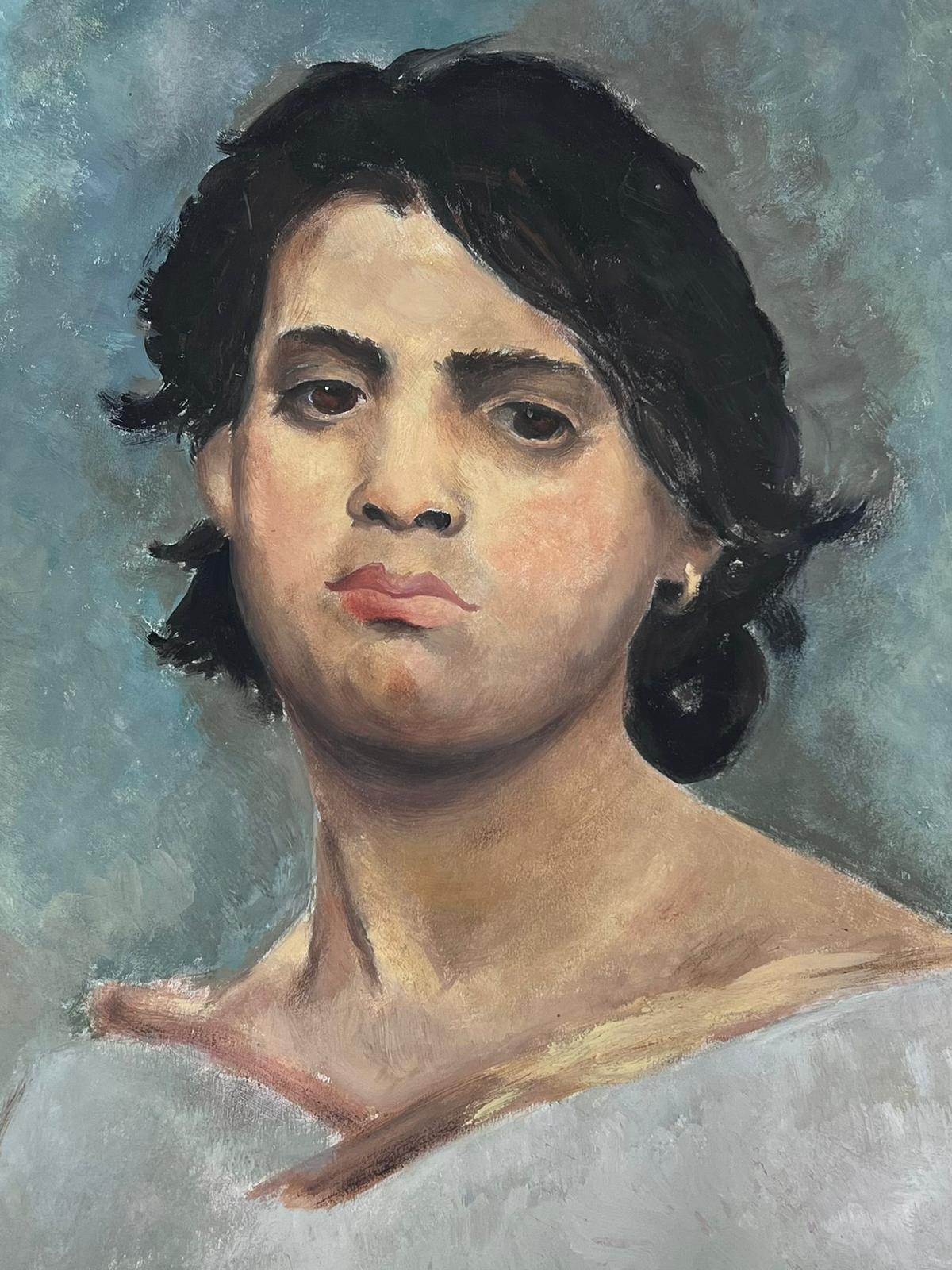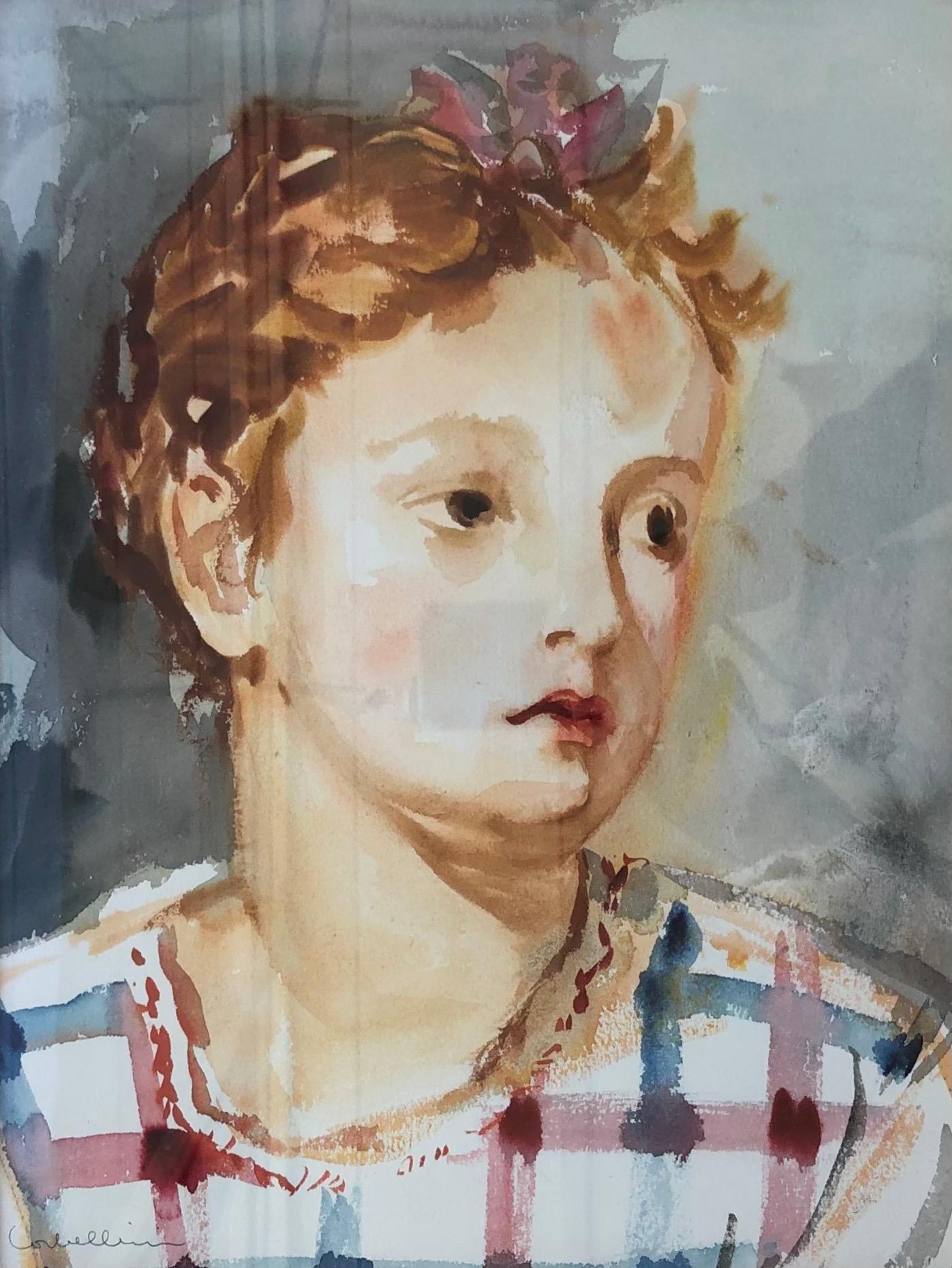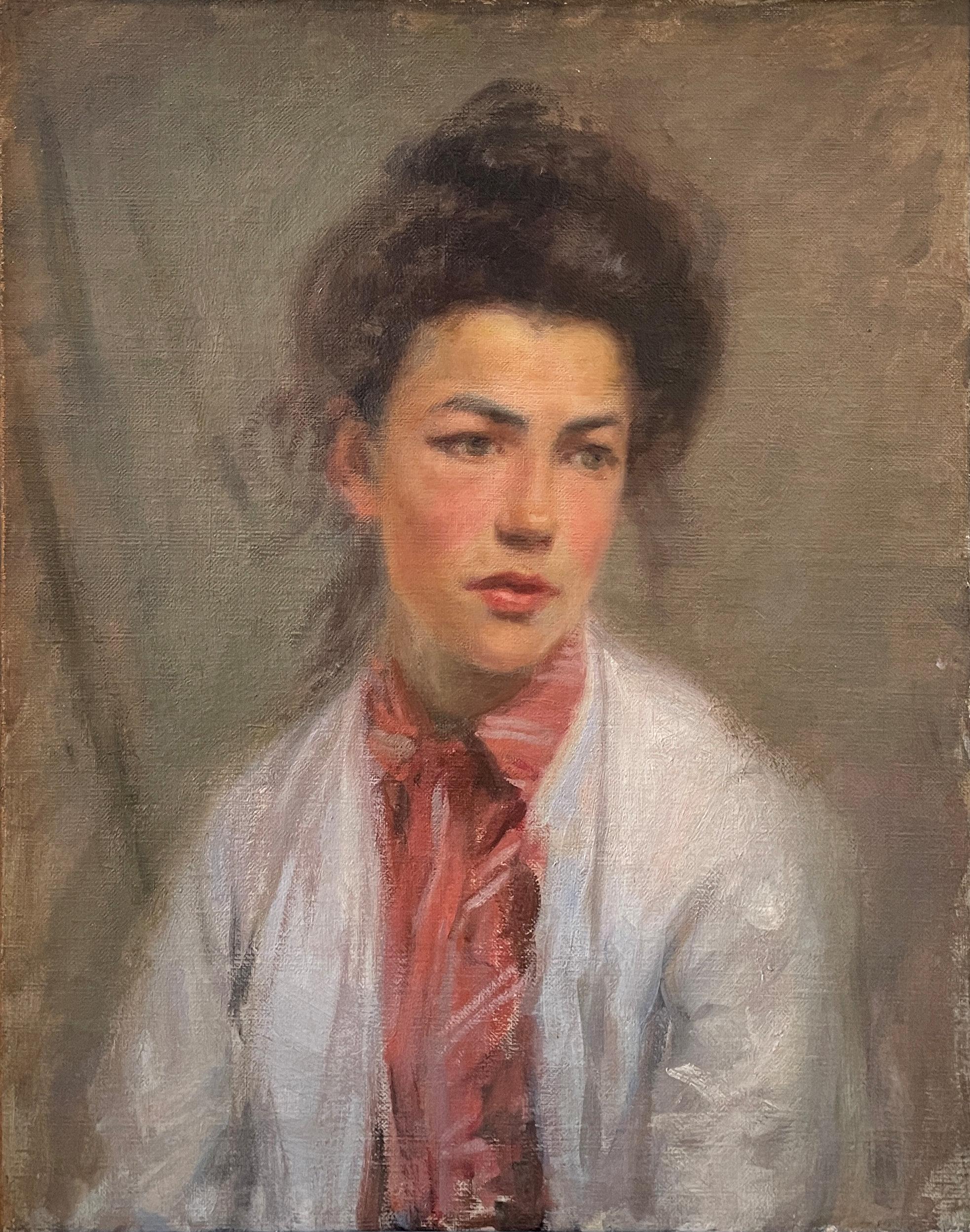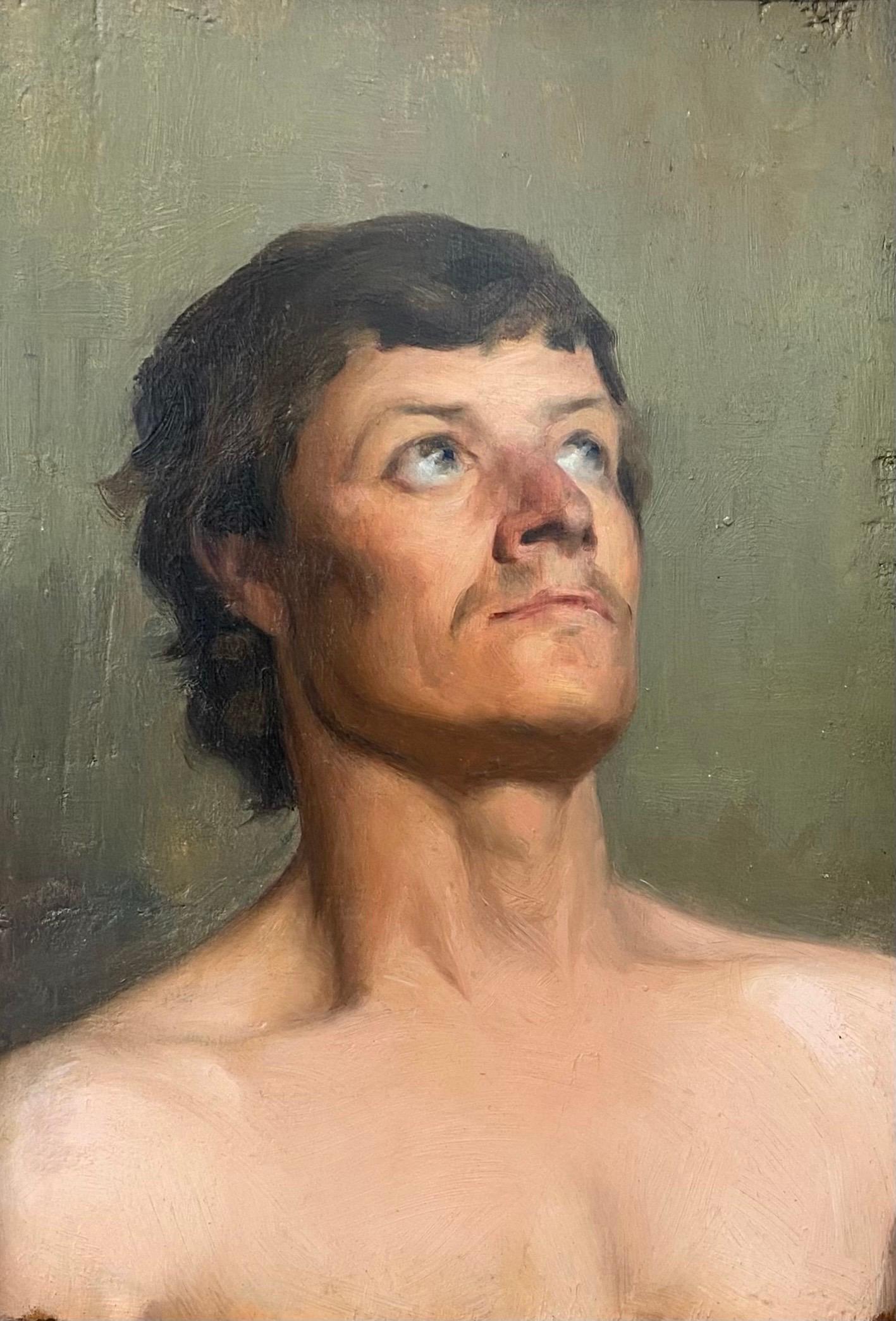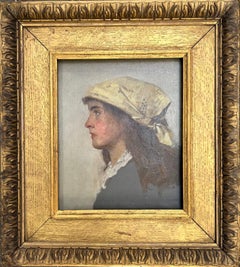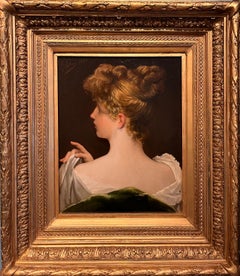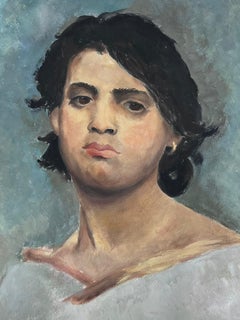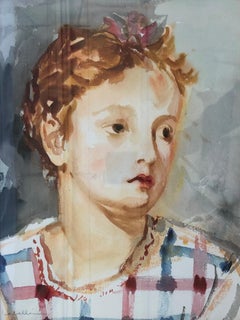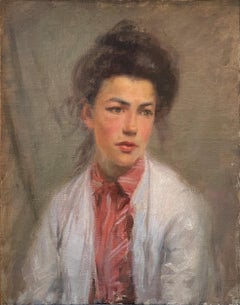Items Similar to Head Study
Video Loading
Want more images or videos?
Request additional images or videos from the seller
1 of 8
Joseph-Auguste RousselinHead Study
$41,331.64
£30,000
€35,034.18
CA$57,226.54
A$62,477.68
CHF 32,754.49
MX$758,815.55
NOK 409,050.31
SEK 386,252.56
DKK 261,492.86
About the Item
Joseph-Auguste Rousselin
French 1841 - 1916
Head Study
Oil on board, signed with initials and signed verso
Image size: 12 x 11 inches
This head study provides an unbelievably moving portrait of an androgynous sitter. Employing incredible technique, the artist has achieved the highly finished porcelain skin, thoughtful eyes and pink lips of the sitter with incredible softness.
The unfinished quality of the background make the composition of the work particularly satisfying to the modern eye. Loosely sketched dashes and brushy swoops outline the model's head. The mix of finished and more expressive elements reveals the artist's brilliant eye, technique and personality.
Artistically, Rousselin does not seem to be influenced by the friendships that he forged with the Impressionists but rather he has remained rather faithful to the academic technique of William Bouguereau, whose studio he also used to frequent.
This study is certainly comparable to the work by Bouguereau, specifically his graceful portraits of women. Bouguereau championed the traditional academic style and his methods were taught to him by a pupil of Ingres. Similar academic inspiration is apparent in this work, from the conscious posing of the subject to the evenly laid colours. Indeed, alike the work of Bouguereau this follows the same classical approach to composition, form and subject matter.
The Artist
Born in Paris in 1841, Rousselin grew up to be a French painter and art collector. From a young age he studied in the workshops of Charles Gleyre and Thomas Couture, here he met the young impressionist generation. His studio peers included Auguste Renoir, Alfred Sisley and Édouard Manet, with whom he forged strong bonds of friendship. It was at his invitation that his two friends Renoir and Sisley exhibited at the Salon of the Society of Friends of the Arts in Pau, a region where Rousselin had family ties.
Manet invited him to his family home in Boulogne-sur-Mer where he had him pose in the summer of 1868 for 'Le Déjeuner dans l'Atelie'. Rousselin can be seen in the background of the painting as the man with the cigar, wearing a grey hat. Rousselin is portrayed as one of those shown in the anonymous 'The 43 Portraits of Painters in the Studio of Charle Gleyre' (Petit Palais, Paris).
Despite his closeness to the Impressionist group, Rousselin nevertheless remained attached in his painting to a certain form of academicism, which led Degas to say in one his notebooks: "Bouguereau will end up raised in its basket. Like Rousselin, you will see”
More than a friend, Rousselin was also a patron of the Impressionists whose paintings he collected. He was also cousin of Renoir's well-known patron Jules Le Coeur.
First a portraitist and genre painter, Rousselin was also a skilled equestrian painter. He produced a variety of distinguished works including many animals and biblical scenes. His works reveal a late realism, served by a sure design and a colourful range of great frankness. He made his debut of work at the Paris Salon in 1863 and exhibited there until at least 1885. Rousselin has works held in various collections including the musée de Grenoble, the musée de Pau and the musée des beaux-arts.
- Creator:Joseph-Auguste Rousselin (1841 - 1916, French)
- Dimensions:Height: 12 in (30.48 cm)Width: 11 in (27.94 cm)
- More Editions & Sizes:1 of 1Price: $41,332
- Medium:
- Movement & Style:
- Period:
- Framing:Framing Options Available
- Condition:
- Gallery Location:London, GB
- Reference Number:1stDibs: LU52410755352
About the Seller
5.0
Vetted Professional Seller
Every seller passes strict standards for authenticity and reliability
Established in 2007
1stDibs seller since 2014
84 sales on 1stDibs
Typical response time: 4 hours
- ShippingRetrieving quote...Shipping from: London, United Kingdom
- Return Policy
Authenticity Guarantee
In the unlikely event there’s an issue with an item’s authenticity, contact us within 1 year for a full refund. DetailsMoney-Back Guarantee
If your item is not as described, is damaged in transit, or does not arrive, contact us within 7 days for a full refund. Details24-Hour Cancellation
You have a 24-hour grace period in which to reconsider your purchase, with no questions asked.Vetted Professional Sellers
Our world-class sellers must adhere to strict standards for service and quality, maintaining the integrity of our listings.Price-Match Guarantee
If you find that a seller listed the same item for a lower price elsewhere, we’ll match it.Trusted Global Delivery
Our best-in-class carrier network provides specialized shipping options worldwide, including custom delivery.More From This Seller
View AllPortrait of a Young Girl, Polish Late 19th Century Oil
Located in London, GB
Szymon Buchbinder
1853 - 1908
Portrait of a Young Girl
Oil on canvas
Image size: 19 x 13 inches
Original frameSimon Buchbinder (1853-1908) was a Polish painter. Most of his works we...
Category
Late 19th Century Portrait Paintings
Materials
Canvas, Oil
Portrait Studies
By Edwin Longsden Long
Located in London, GB
Edwin Long
1829 - 1891
Portrait Studies
Graphite on paper
Image size: 4 x 8 inches (10 x 20.5 cm)
Framed
Edwin Longsden Long RA (1829-1891, British) wa...
Category
1850s Pre-Raphaelite Portrait Drawings and Watercolors
Materials
Graphite
Portrait of a Jo James
Located in London, GB
James Kerr Lawson
1862-1939
Portrait of a Jo James
Oil on canvas
Image size: 13 x 11 1/8 inches (33 x 28.3 cm)
This portrait depicts a young girl in a simple headscarf in a perspect...
Category
19th Century Portrait Paintings
Materials
Canvas, Oil
Jeunesse
Located in London, GB
Louis Joseph Lebrun
Belgian 1844-1900
Portrait of a Young Woman
Oil on panel, signed and dated '1884' upper left, labelled verso
Image size:15 3/4 x 12 ½ inches (40 x 31.5 cm)
Ornate...
Category
19th Century Portrait Paintings
Materials
Oil, Panel
Study of Desirée
By Stanhope Alexander Forbes
Located in London, GB
Stanhope Alexander Forbes
1857-1947
Study of Desirée
Oil on canvas
Image size: 18 1/4 x 12 1/2 inches (46.4 x 31.8 cm)
Dutch-style ebonised frame
Provenance
Private collection, Bri...
Category
19th Century Portrait Paintings
Materials
Canvas, Oil
Portrait of a Lady, Early 20th Century Oil
By Arthur Ambrose McEvoy
Located in London, GB
Follower of Ambrose McEvoy
Circa 1910
Portrait of a Lady
Oil on canvas
Image size: 20 x 16 inches (51 x 40.5 cm)
Original ebonised Frame
A stunning portrait of a lady with flami...
Category
Early 20th Century Portrait Paintings
Materials
Canvas, Oil
You May Also Like
20th Century Portrait of Woman Head & Shoulders Study
By Josine Vignon
Located in Cirencester, Gloucestershire
Josine Vignon (French 1922-2022) ...
Category
Mid-20th Century Impressionist Portrait Paintings
Materials
Oil
$540 Sale Price
20% Off
Frédérica portrait
By Luigi Corbellini
Located in Genève, GE
This portrait captures the pensive gaze of a young girl, illustrating a remarkable emotional depth. The artist subtly uses watercolors to create a vaporous effect, accentuating the s...
Category
Mid-20th Century Italian School Portrait Paintings
Materials
Watercolor
"Marion Jones Farquhar" Frederick William Macmonnies, Tennis Olympian Portrait
By Frederick William MacMonnies
Located in New York, NY
Frederick William Macmonnies
Marion Jones Farquhar, 1905-11
Oil on canvas
24 x 20 inches
Provenance:
William Clerk
Private Collection, New York
Literature:
Mary Smart, A Flight with Fame: The Life and Art of Frederick MacMonnies, with a Catalogue Raisonne of Sculpture and a Checklist of Paintings by E. Adina Gordon, Madison, Connecticut, 1996, no. 90.
The work depicts Marion Jones Farquhar who, was an American tennis player who competed during the late 19th century and early 20th century. She won the singles titles at the 1899 and 1902 U.S championships and was the first American woman to medal at the Olympics placing Bronze in singles. Additionally, she was the artist's sister-in-law who often played and competed with MacMonnies in golf and tennis. MacMonnies would often study the movements of her form referenced in his sculpture. When MacMonnies won a doubles golf tournament he said "Marion dragged my dead weight thro' and won us the tournament, showing what great Generalship can do."
A sculptor of classical figures, American-born Frederick MacMonnies had fame in the United States and Europe in the later half of the 19th century and early 20th century. He occasionally returned to America but lived most of his life as in expatriate in France. He was especially known for his lithe bronze figures, especially ones titled Diana. The classical names of these figures allowed him the appearance of propriety but gave him the opportunity to model svelte nudes.
Frederick MacMonnies was one of the first American sculptors to recognize the potential market of the middle class. He copyrighted his works and then contracted with foundries to mass produce some of his figures such as Diana in smaller sizes.
MacMonnies was born in Brooklyn, New York, and was a child prodigy at carving stone. At age 18, he worked in the studio of Augustus Saint-Gaudens, and then persuaded him to become his assistant, keeping models damp and covered, running errands, and cleaning the studio. Evenings he studied at the Art Students League, Cooper Union, and the National Academy of Design.
In Saint-Gaudens' studio, he met many of the wealthy people who shared Saint-Gaudens Beaux-Arts based ideas that art and architecture should be unified in order to create public art in America equal to that of classical antiquity or Renaissance Europe. Among the men that MacMonnies met through Saint-Gaudens who later furthered his career were architects Stanford White and Charles McKim...
Category
Early 1900s American Impressionist Portrait Paintings
Materials
Canvas, Oil
Oil Painting by Henri Benard "Portrait of Aliette de Pigeard"
Located in Mere, GB
Oil Painting by Henri Benard "Portrait of Aliette de Pigeard" 1860- 1927 Aliette de Pigeard (1897 - 1969) married Pedro de Prat, Marquis de Nantouillet, a Spanish ambassador. Their d...
Category
Early 1900s Portrait Paintings
Materials
Oil
French School 19th Century, A Man bust-length, oil on wood panel
Located in Paris, FR
French School of the 19th Century
A Man bust-length
Oil on wood panel
31,5 x 22 cm
Framed 47,8 x 37,5 cm
In good condition. The painter chose to deal with the roughness of his suppo...
Category
1850s Romantic Portrait Paintings
Materials
Oil
Antonin MERCIE (1845-1916) French Belle Époque Portrait
By Marius Jean Antonin Mercié
Located in Holywell, GB
Antonin MERCIE (1845-1916) French Belle Époque Portrait
A stylish portrait of a fashionable young woman dating to the Belle Époque period. Signe...
Category
1890s Impressionist Portrait Paintings
Materials
Oil
More Ways To Browse
Antique Head
19th Century Oil Portrait Child
Gold Portrait Frame
Warhol Acrylic
1900 Portrait Of A Woman Oil
Full Length Portrait Oil Painting
Portrait Beautiful Woman
Portrait Painting Man In Suit
Oil Portrait Young Girl
Oil Painting Of Victorian Lady
Pair Of 19th Century Oil Portraits
Portrait Of A Handsome Man
Pair 19th Century Oil Portrait Paintings
Natasha Lelenco
Portrait Painting Girl 19th
Old Man Painting
19th Century Portrait Of Young Boy
Portrait Daughter
